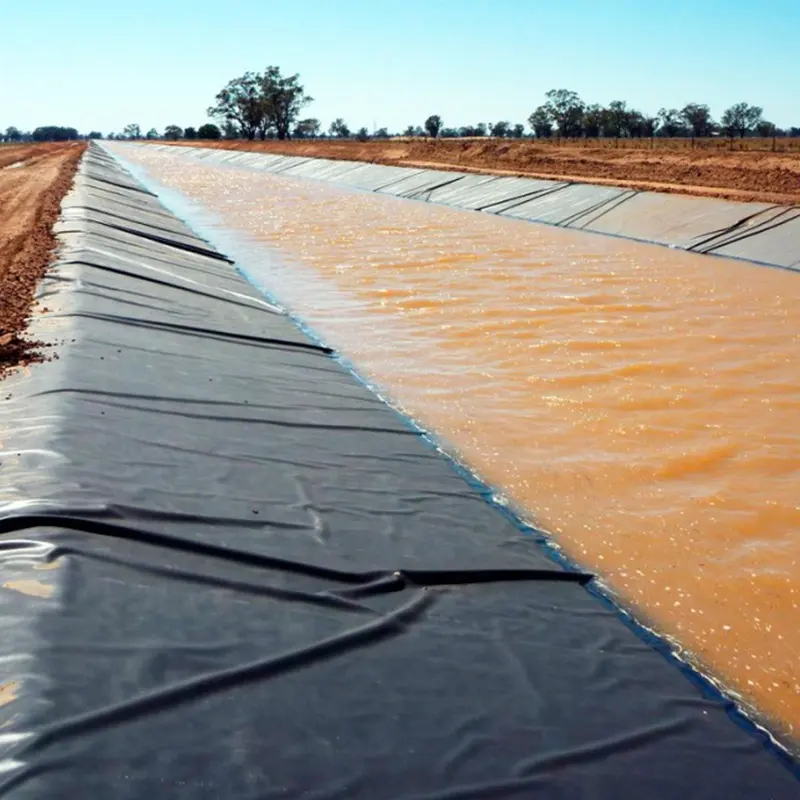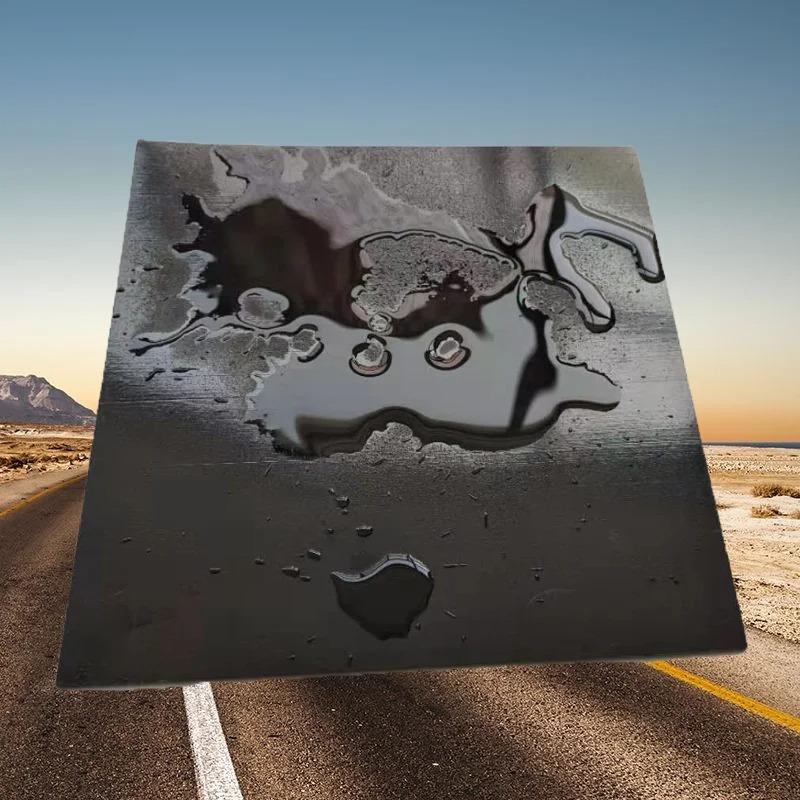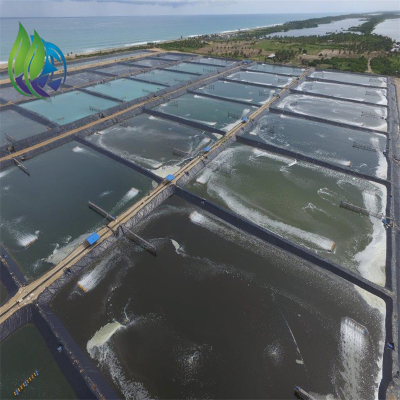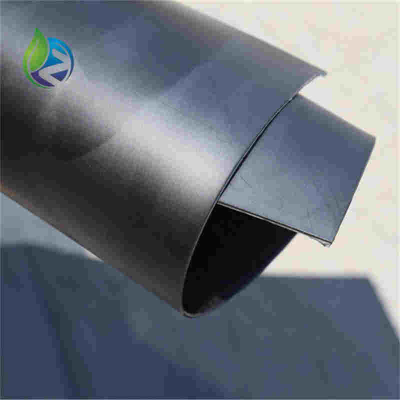A Brief Discussion on the Construction Plan of HDPE Composite Geotextile for Channel Anti-seepage River Management
The loss of water due to channel leakage not only reduces the water utilization coefficient, wastes precious water resources, but also causes the groundwater level to rise and leads to soil salinization in farmland. Only by adopting effective anti-seepage engineering measures can the leakage water volume in the channels be reduced.
The HDPE Composite Geotextile has the following advantages for use in channel seepage prevention projects:
1)Excellent seepage prevention performance. Practice has shown that the membrane-sealed channels can generally reduce seepage losses by 90-95%.
2) Light weight, low usage, and low transportation volume.
3) Strong adaptability to deformation.
4) Simple construction, short construction period.
5) Strong corrosion resistance.
6) Low cost.
When using the HDPE Composite Geotextile for channel seepage prevention projects, an appropriate type and specification should be selected based on water level, geological conditions, and project scale, and different construction technical schemes should be determined.
2. Selection of Materials
The membrane materials should be selected according to the following principles:
1) For general medium-sized and small-scale channels, a dark-colored plastic membrane with a thickness of 0.18 to 0.22 mm is recommended. In cold regions, polyethylene membranes can be given priority; in areas with dense growth of reed and other penetrating plants, polyvinyl chloride membranes can be given priority.
2) For projects with poor geological and hydrogeological conditions, large amounts of frost heave in the foundation soil, or higher standards of seepage prevention, a composite HDPE Composite Geotextile (1 layer fabric + 1 layer membrane, 2 layers fabric + 1 layer membrane) is recommended. This membrane material has the comprehensive functions of seepage prevention and surface water drainage, high strength, good resistance to puncture, anti-aging and other properties, and no need for a transition layer.
3 Basic Structure and Requirements
Based on the engineering situation, a single-layer waterproofing structure, a double-layer waterproofing structure, or a composite waterproofing structure can be selected. The waterproofing structure includes the upper cushion layer, the lower cushion layer, the protective layer on the upper part of the cushion layer, the support layer at the lower part of the cushion layer, and the drainage layer.
Construction plan for HDPE composite geotextile in channel waterproofing and river regulation
1) Support layer; According to the engineering category, natural foundation conditions, and the characteristics of the used geotextile, a selection is made. Generally, a 50-150mm thick good sand soil is used. A layer of geosynthetic material or a layer of geosynthetic material covering on the sand soil layer can also be used.
2) Lower cushion layer; Use a layer of fine soil material, fine sand layer, concrete layer, geotextile, geonet, etc., with a thickness of more than 100mm and compacted densely. When the base soil is uniform and flat fine-grained soil or a composite geotextile is used, a lower cushion layer may not be necessary.
3) Drainage layer; When the groundwater level is high and there is an internal water pressure effect, a drainage layer or drainage and exhaust facilities such as water stop valves, drainage pipes, longitudinal and transverse drainage ditches should be laid between the support layer and the geotextile.
4) Upper cushion layer; Use foam plastic sheeting, HDPE Composite Geotextile, gravel material, sandless concrete, asphalt concrete, geonet, etc. When the protective layer is a sufficiently thick compacted fine-grained soil or a composite geotextile is used, an upper cushion layer may not be necessary.
5) Protective layer. Depending on the type of anti-seepage geotextile membrane and the upper bedding layer, as well as the slope of the channel, and in accordance with the anti-freezing requirements, it can be made of compacted soil, gravel, precast or cast-in-place concrete slabs, rubble masonry or dry masonry.
4. Laying Method
According to the scope of membrane laying, it is divided into three types: full laying, semi-laying, and bottom laying. Among them, semi-laying and bottom laying are mainly applicable to wide and shallow channels or channels with trees on the slope during renovation.
1) Full laying; full laying on the slope and bottom of the channel. The laying method can be selected based on the anti-sliding stability of the channel slope. Specific methods include: trapezoidal, stepped, zigzag, pentagonal, etc.
2) Semi-laying; full laying on the bottom of the channel, with the laying height of the membrane on the slope being 1/2 to 1/3 of the normal water level of the channel.
3) Bottom laying. Only the bottom of the channel is laid.
5 Channel Construction Project
Construction procedures: Clean the foundation trench → Lay the HDPE Composite Geotextile → Conduct joint construction and inspection → Connect and anchor to the surrounding area → Conduct acceptance inspection → Construct the protective layer.
5.1 Clean the base trench
According to the design, remove all debris that may damage the HDPE Composite Geotextile, such as silt, garbage, trees, grass roots, stones, etc. on the surface of the base layer within the area where the geotextile membrane is laid. Level and compact the soil, repair any depressions or cracks, and dig the anchoring ditch. If there are corners on the base layer, round them, with a radius of no less than 0.5 meters; in areas with standing water and high groundwater levels, drainage should be carried out.
5.2 Geotextile membrane laying
Select the appropriate joint splicing method according to the type of HDPE Composite Geotextile and design requirements.
1) When choosing the welding joint, the construction process is as follows: laying and cutting → aligning and overlapping → applying the membrane for shaping → wiping off dust → welding and inspection → welding → inspection and repair → re-inspection → acceptance.
2) When choosing the HDPE Composite Geotextile, the construction process is: laying and welding the membrane → sewing the base fabric → sewing the surface fabric (2 layers of fabric and 1 layer of membrane). The sewing should be moderately tight and natural, ensuring that the membrane and the fabric bear the force together.
3) When laying the HDPE Composite Geotextile, based on the actual engineering conditions, the laying direction should be determined according to the principle of minimizing the number of seams, facilitating construction, and having reasonable cutting. The seams should avoid bends and be placed on the plane.
4) When the foundation trench is made of soil, it should be moistened with water first to ensure a close bond between the HDPE Composite Geotextile and the channel bed foundation trench. When the foundation trench is a concrete structure, it is advisable to use long filament hot-rolled composite geotextile membrane and cement glue with (cement weight) 2.0%SBC120 to bond with the foundation trench.
5) When laying the HDPE Composite Geotextile, it should be laid parallel or perpendicular to the slope line from downstream to upstream, without being too tight. A 1.5% relaxation allowance should be left in both the longitudinal and transverse directions.
6) The laying height of the HDPE Composite Geotextile on the channel slope should reach above the highest water level and have a certain overhang. The overhang value should be determined based on the water level or wave rise and should not be less than 0.5m and should be fixed.
7) During HDPE Composite Geotextile welding, the base surface should be dry, with a moisture content of less than 15%, and the membrane surface should be wiped clean with dry gauze.
5.3 Connection and Anchoring
1) The connection between the HDPE Composite Geotextile and the soil base: The HDPE Composite Geotextile is directly buried in the anchoring trench, filled with soil and compacted. No water leakage or pull-out should occur at the anchoring point.
2) The connection between the geotextile membrane and the building's concrete: It can be secured by using angle steel or metal strips for riveting, or fixed to the concrete layer with bolts.
5.4 Construction of Protective Layer
1) When the protective layer is a concrete structure, expansion joints should be reserved as per the design.
2) When using the compaction method to fill the soil protective layer, the sheep's horn roller should not be used.
3) When using the water immersion and compaction method to fill sandy loam, light loam and medium loam protective layers, the filling section size should reserve 10-15% of the settlement amount. After the repeated water immersion settlement stabilizes, slowly drain the water, fill the cracks, and compact them, and then shape them into the design-required section.
4) The bottom of the canal, the slope of the canal, or different canal sections can adopt a combined protective layer with different erosion resistance and different materials.
6. Notes
1) The excavation section and elevation of the channel must comply with the design requirements. The excavation section of the channel bed should avoid excessive excavation. The filling section should be moistened and compacted layer by layer. The collapsible channel section should undergo water immersion pre-collapse or strong compaction to avoid large deformation.
2) For projects with freeze protection requirements, the anti-seepage structure should take anti-freezing measures. A hard foam plastic insulation layer can be laid under the anti-seepage layer, or non-frosting soil can be replaced. In general, the insulation layer can be laid throughout the section.







